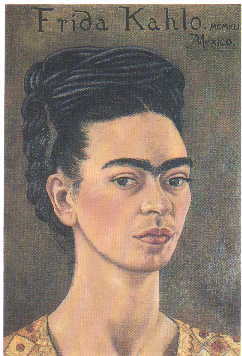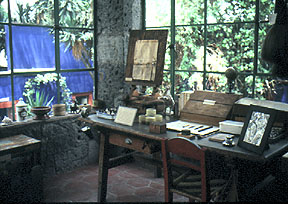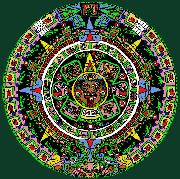KAHLO'S STAR
RISES:
FRIDAMANIA
ERUPTS AGAIN ON BOTH SIDES OF THE BORDER
by Ron Butler
 The frenzy that was Frida
Kahlo several years ago and then died off somewhat, has erupted again. A
new film about the tragic surrealist artist, wife of famed Mexican
muralist Diego Rivera, is scheduled for U.S. release in October. The frenzy that was Frida
Kahlo several years ago and then died off somewhat, has erupted again. A
new film about the tragic surrealist artist, wife of famed Mexican
muralist Diego Rivera, is scheduled for U.S. release in October.
Once again, Fridamania
merchandise -- T-shirts, posters, Frida and Diego salt and pepper
shakers, furniture designs, calendars, key rings, ashtrays, jewelry,
dolls and figurines -- is being dusted off and placed on front shelves.
In the spring of 2000, an
early Frida self-portrait sold for over 5 million dollars at Sotheby's
in New York, setting a new world record for Latin American art, a new
record for Frida and a new record for any female artist.
Last June, the U.S. post
office issued a 34-cent commemorative stamp featuring a 1934
self-portrait by the artist, the first time a Hispanic woman has been
recognized on a U.S. stamp. Kahlo also gets superstar
billing in Mexico City, where her former house and studio in the trendy
San Angel district is now open to the public.
It adjoins the
long-popular Diego Rivera Studio Museum which occupies the Mexican
muralist's former home and workplace he shared with Kahlo just after
their marriage in 1929. I visited the new museum
on a recent trip to Mexico City and came away, as always, awed and
dazzled. One doesn't experience Kahlo lightly. It's like plunging into
the epicenter of a starburst. The crucible of this
talented couple's genius, their former home-turned-museum is considered
the first example of avant-garde architecture in Mexico.
Both three-story houses
were designed in Bauhaus style by artist Juan O'Gorman, a long-time
friend of Rivera's. The second house, which was exclusively Kahlo's
(Rivera liked lots of guests around; Kahlo preferred to work alone) had
been closed for 25 years and was used primarily for storage.
 After extensive
restoration, including an exterior coat of cobalt blue paint trimmed in
red to match Frida's Casa Azul, the Blue House, in Coyoacan, it becomes
part of what has been known since 1958 as the Diego Rivera Studio
Museum. The combined facility is now called The Diego Rivera and Frida
Kahlo Studio-House Museum. After extensive
restoration, including an exterior coat of cobalt blue paint trimmed in
red to match Frida's Casa Azul, the Blue House, in Coyoacan, it becomes
part of what has been known since 1958 as the Diego Rivera Studio
Museum. The combined facility is now called The Diego Rivera and Frida
Kahlo Studio-House Museum.
The two houses are
connected by a second-floor walkway. Their architecture illustrates the
independence the couple maintained throughout their caring but
unconventional union. Ruth and Guadalupe,
Rivera's children from his second wife, Lupe Marin, were frequent
visitors, as was Marin herself, who became one of Kahlo's closest
friends. In the center of it all,
between the tables, chairs, sofas and paint pigments, was that whirlwind
of creativity known as Diego Rivera.
While in Mexico City, I
called upon one of Frida's former art students, Fanny Rabel, now a
painter of considerable renown.
"Frida cared for
Diego as though he was her son," she told me. "I viewed Diego
as a giant and Frida was fine delicate and enchanting. But he treated
her like the heavens and with protection that she needed as a woman with
the impediments that she had. Really, she was a very fragile woman, very
delicate."
Rivera earned his
reputation through mural painting but paid his bills with easel and
portrait commissions. Some of his most famous works were completed at
the San Angel studio, including "Nude With Gannets," "The
Painter's Studio," "Portrait of Dolores Olmeda,"
"Woman in White" and "The Watermelons." It was also
here that he painted family portraits that reflected love and
tenderness.
Some of Kahlo's more
notable works done here were "The Two Fridas,"
"Self-Portrait with Monkey," "The Fruit of the Land"
and "Little Dead Dimas."
The home became something
of a mecca for intellectuals of the day -- writers Pablo Neruda, Andre
Breton, John Dos Pasos and Waldo Frank, artist Henry Moore,
photographers Edward Weston, and Manuel Alvarez Bravo, celebrated
actresses Dolores del Rio, Maria Felix and Paulette Goddard.
Among the many famous
houseguests was film star Edward G. Robinson and his wife Gladys. While
Kahlo entertained Mrs. Robinson on the roof terrace of her house,
Rivera, always his wife's biggest fan, showed the actor some of her
paintings. Robinson bought four of them for 200 dollars each, at the
time Kahlo's most substantial sale.
It is not surprising that
the San Angel home would be unveiled as yet another Kahlo shrine.
Interest in her life and work of late, a phenomenon known within art
circles as Fridamania, has been nothing short of phenomenal.
"Frida was very
beautiful and charming and funny," said her former student Fanny
Rabel. "She had a good sense of humor. And this is an amazing
quality for a person that suffered everything."
The Diego Rivera and
Frida Kahlo Studio-House Museum is at Diego Rivera 2, San Angel (Mexico
City).
ABOUT THE AUTHOR
Ron Butler is the
author of Dancing Alone in Mexico, a travel narrative recently
published by the University of Arizona Press. He lives in Tucson. |

